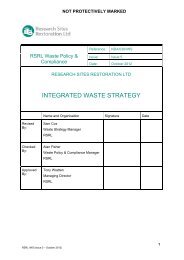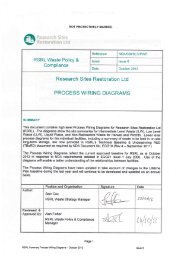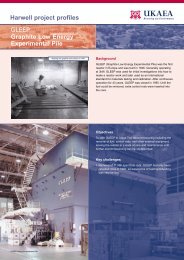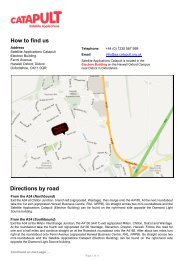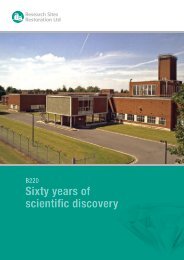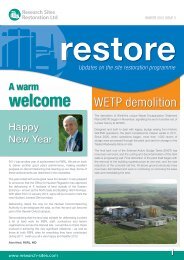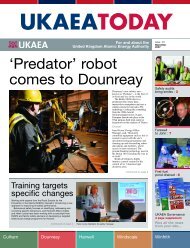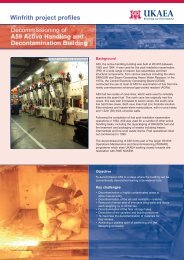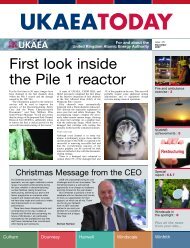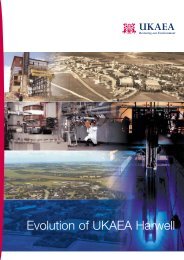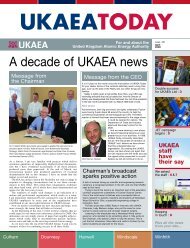Harwell-Catapult-pit - Research Sites Restoration Ltd
Harwell-Catapult-pit - Research Sites Restoration Ltd
Harwell-Catapult-pit - Research Sites Restoration Ltd
You also want an ePaper? Increase the reach of your titles
YUMPU automatically turns print PDFs into web optimized ePapers that Google loves.
<strong>Harwell</strong> project profiles<br />
<strong>Restoration</strong> of the<br />
RAF <strong>Catapult</strong> Pit<br />
One of two launch slots for the RAF MK III catapult system<br />
Background<br />
The <strong>Catapult</strong> Pit was constructed at RAF <strong>Harwell</strong> in the late<br />
1930s to house a prototype pneumatic catapult system<br />
designed to assist the take-off of bomber aircraft. The<br />
structure, which was below ground, originally consisted of a<br />
30m diameter turntable and two 85m launch trenches.<br />
The <strong>pit</strong> was never successfully used to launch aircraft and<br />
was backfilled by UKAEA in the 1950s after using it as a<br />
transit store for waste materials.<br />
Located near the main entrance to the <strong>Harwell</strong> site, the<br />
catapult <strong>pit</strong> is on land which is accessible to the public.<br />
Site investigation by UKAEA in 1997 showed a small quantity<br />
of uranium ore might be present in the <strong>pit</strong>.<br />
Objectives<br />
To restore the <strong>Catapult</strong> Pit to a safe and clean state – removing<br />
any residual risks to the public, ground water and the<br />
environment.<br />
The turntable <strong>pit</strong> exposed for the first time in 50 years<br />
Key challenges<br />
• Removing the chemical and radioactive materials from the <strong>pit</strong>.<br />
• Ensuring that the original <strong>Catapult</strong> Pit is in sound structural<br />
condition and that no damage occurs to it during remediation.<br />
Aerial view showing an outline of the<br />
remaining concrete structure<br />
• Minimising impact to the public and users of the <strong>Harwell</strong> site<br />
and the local roads and footpaths.
Solution<br />
Removing original infill soils inside the temporary weatherproof canopy<br />
The <strong>pit</strong> was excavated in 300mm layers and thoroughly<br />
examined for contaminants, any contaminated materials were<br />
then removed in 150mm layers and disposed of through the<br />
appropriate off-site facilities. Representative samples from<br />
every 3m3 were taken for on-site laboratory analysis to ensure<br />
waste was correctly consigned.<br />
Excavation and waste handling was carried out inside two<br />
temporary weatherproof structures (50mx50mx6m high), one<br />
over the former turntable and the other which was moved<br />
across the site as the trenches were excavated.<br />
The work, which was of low hazard to workers and the public,<br />
was carried out using proven techniques. Precautionary safety<br />
measures and careful working practices minimised exposure<br />
to contaminated dusts.<br />
A temporary 2.5m fence was erected to control site access<br />
and the public were kept at a distance of 30m from the work.<br />
Hygiene control stations were used to monitor personnel,<br />
plant, equipment and waste materials. Four air-monitoring<br />
stations were set-up on the perimeter of the site to measure<br />
any discharges, whilst the environment inside and outside the<br />
weatherproof structures was also regularly monitored for<br />
chemical and radioactive materials and dusts.<br />
Outcome<br />
• UKAEA has successfully removed all the waste material in the <strong>pit</strong>.<br />
• The structure of the <strong>Catapult</strong> Pit was exposed for the first time in<br />
50 years and was proven to be sound.<br />
• RAF restoration enthusiasts visited the ‘exposed’ <strong>pit</strong> to gather<br />
information.<br />
• The <strong>pit</strong> has been backfilled with clean materials, top soil,<br />
grass-seeded and the land is once again available for use as a<br />
sports field.<br />
RAF restoration enthusiasts photograph an exposed launch trench<br />
Key facts<br />
• Total soil shifted<br />
• Diameter of turntable <strong>pit</strong><br />
• Depth of <strong>pit</strong><br />
• Length of trenches<br />
• Analysis of <strong>pit</strong><br />
• Excavated waste<br />
Timescales<br />
• Start of site work February 2002<br />
• Completion of site work June 2002<br />
5,100 tonnes<br />
30 metres<br />
3 metres<br />
85 metres<br />
1,600 radiological samples<br />
1,000 chemical samples<br />
4 half-height ISO containers and 6 two hundred litre<br />
drums of low level waste. The majority of the waste<br />
was natural uranium<br />
Contact:<br />
Nick Hance<br />
<strong>Harwell</strong> Public Relations Manager<br />
Tel: 01235 436909<br />
Email: nick.hance@ukaea.org.uk



